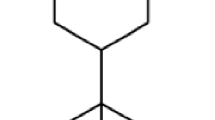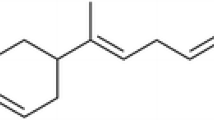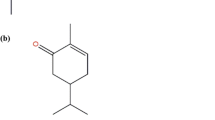Abstract
The mosquito larvicidal activity of Zanthoxylum monophyllum leaf essential oil (EO) and its major chemical constituents was tested against the three mosquito vectors Anopheles subpictus, Aedes albopictus and Culex tritaeniorhynchus. In the EO of Z. monophyllum, it contains 36 compounds with the two major compounds being Germacrene D-4-ol (19.40 %) and α-Cadinol (12.30). The larvicidal activity of the essential oil against An. subpictus, Ae. albopictus and Cx. tritaeniorhynchus was determined and LC50 values were estimated at 41.50, 45.35 and 49.01 µg/mL, respectively. The two major compounds Germacrene D-4-ol and α-Cadinol were tested for acute toxicity against larvae of the three mosquito vectors. Germacrene D-4-ol showed a significantly higher efficacy compared to α-Cadinol. While LC50 for Germacrene D-4-ol ranged from 6.12 to 7.26 µg/mL, LC50 values for α-Cadinol were estimated in the range from 10.27 to 12.28 µg/mL. The EO, Germacrene D-4-ol and α-Cadinol were found safer to the non-target organism Gambusia affinis (LC50 = 4234.07, 414.05 and 635.12 µg/mL, respectively), which was manifested in the high suitability of the index/predator safety factor value, ranging from 86.36 for the least sensitive larvae of Cx. tritaeniorhynchus to 102.02 for the most sensitive larvae of An. subpictus.

Similar content being viewed by others
References
Abbott WS (1925) A method of computing the effectiveness of an insecticide. J Econ Entomol 18:265–267
Adesina SK (2005) The Nigerian Zanthoxylum; chemical and biological values. Afr J Tradit Complement Altern Med 2:282–301
Bakkali F, Averbeck S, Averbeck D, Idaomar M (2008) Biological effects of essential oils—a review. Food Chem Toxicol 46:446–475
Barkatullah Ibrar M, Muhammad N, Ur-Rehman I, Rehman MU, Khan A (2013) Chemical composition and biological screening of essential oils of Zanthoxylum armatum DC leaves. J Clin Toxicol 3:172. doi:10.4172/2161-0495.1000172
Benelli G (2015a) Research in mosquito control: current challenges for a brighter future. Parasitol Res 114:2801–2805
Benelli G (2015b) Plant-borne ovicides in the fight against mosquito vectors of medical and veterinary importance: a systematic review. Parasitol Res 114:3201–3212
Benelli G, Murugan K, Panneerselvam C, Madhiyazhagan P, Conti B, Nicoletti M (2015) Old ingredients for a new recipe? Neem cake, a low-cost botanical by-product in the fight against mosquito-borne diseases. Parasitol Res 114:391–397
Borah R, Saikia K, Talukdar AK, Kalita MC (2012) Chemical composition and biological activity of the leaf essential oil of Zanthoxylum oxyphyllum. Planta Med 78:P_100
Burt S (2004) Essential oils: their antibacterial properties and potential applications in foods—a review. Int J Food Microbiol 94:223–253
Conti B, Flamini G, Cioni PL, Ceccarini L, Leonardi MM, Benelli G (2014) Mosquitocidal essential oils: are they safe against non-target aquatic organisms? Parasitol Res 113:251–259
Cuca LE, Martinez JC, Monache FD (1998) Constituyentes químicos de Zanthoxylum monophyllum. Rev Colomb Quim 27:17–27
De García LA, Calle J, Reguero MT, Nathan PJ (1989) Phytochemical study of Zanthoxylum monophyllum. Fitoterapia 60:447–448
Deo PG, Hasan SB, Majumdar SK (1988) Toxicity and suitability of some insecticides for household use. Int Pest Control 30:118–129
Dias N, Moraes DFC (2014) Essential oils and their compounds as Aedes aegypti L. (Diptera: Culicidae) larvicides: review. Parasitol Res 113:565–592
Finney DJ (1971) Probit analysis. Cambridge University Press, London
Gilani SN, Khan AU, Gilani AH (2010) Pharmacological basis for the medicinal use of Zanthoxylum armatum in gut, airways and cardiovascular disorders. Phytother Res 24:553–558
Gómez Y, Gil K, González E, Farías LM (2007) Actividad antifúngica de extractos orgánicos del árbol Fagara monophylla (Rutaceae) en Venezuela. Int J Trop Biol 55:767–775
Govindarajan M (2010) Chemical composition and larvicidal activity of leaf essential oil from Clausena anisata (willd.) Hook. F. Benth (Rutaceae) against three mosquito species. Asian Pac J Trop Med 3:874–877
Govindarajan M (2011) Larvicidal and repellent properties of some essential oils against Culex tritaeniorhynchus Giles and Anopheles subpictus Grassi (Diptera: Culicidae). Asian Pac J Trop Med 4:106–111
Govindarajan M, Sivakumar R, Rajeswari M, Yogalakshmi K (2012) Chemical composition and larvicidal activity of essential oil from Mentha spicata (Linn.) against three mosquito species. Parasitol Res 110:2023–2032
Govindarajan M, Sivakumar R, Rajeswary M, Yogalakshmi K (2013) Chemical composition and larvicidal activity of essential oil from Ocimum basilicum (L.) against Culex tritaeniorhynchus, Aedes albopictus and Anopheles subpictus (Diptera: Culicidae). Exp Parasitol 134:7–11
Govindarajan M, Rajeswary M, Hoti SL, Benelli G (2016) Larvicidal potential of carvacrol and terpinen-4-ol from the essential oil of origanum vulgare (lamiaceae) against Anopheles stephensi, Anopheles subpictus, Culex quinquefasciatus and culex tritaeniorhynchus (Diptera: Culicidae). Res Vet Sci. doi:10.1016/j.rvsc.2015.11.011
Hemingway J, Ranson H (2000) Insecticide resistance in insect vectors of human disease. Ann Rev Entomol 45:371–391
Isman MB (2006) Botanical insecticides, deterrents, and repellents in modern agriculture and an increasingly regulated world. Annu Rev Entomol 51:46–66
Isman MB, Grieneisen ML (2014) Botanical insecticide research: many publications, limited useful data. Trends Plant Sci 19:140–145
Lawrence C, Rutherford N, Hamilton R, Meredith D (2016) Experimental evidence indicates that native freshwater fish outperform introduced Gambusia in mosquito suppression when water temperature is below 25°C. Hydrobiologia 766:357–364
Liu XC, Liu QY, Zhou L, Liu QR, Liu ZL (2014) Chemical composition of Zanthoxylum avicennae essential oil and its larvicidal activity on Aedes albopictus Skuse. Trop J Pharm Res 13:399–404
McCaffery A, Nauen R (2006) The Insecticide Resistance Action Committee (IRAC): public responsibility and enlightened industrial self interest. Outlook Pest Manag 17:11–14
Nerio LS, Olivero-Verbela J, Stashenko E (2010) Repellent activity of essential oils: a review. Bioresour Technol 101:372–378
Pavela R (2007) Lethal and sublethal effects of thyme oil (Thymus vulgaris L.) on the house fly (Musca domestica Lin.). J Essent Oil Bear Pl 10:346–356
Pavela R (2011) Insecticidal properties of phenols on Culex quinquefasciatus Say and Musca domestica L. Parasitol Res 190:1547–1553
Pavela R (2014a) Insecticidal properties of Pimpinella anisum essential oils against the Culex quinquefasciatus and the non-target organism Daphnia magna. J Asia Pac Entomol 17:287–293
Pavela R (2014b) Acute, synergistic and antagonistic effects of some aromatic compounds on the Spodoptera littoralis Boisd. (Lep., Noctuidae) larvae. Ind Crop Prod 60:247–258
Pavela R (2015a) Essential oils for the development of eco-friendly mosquito larvicides: A review. Ind Crops Prod 76:174–187
Pavela R (2015b) Acute toxicity and synergistic and antagonistic effects of the aromatic compounds of some essential oils against Culex quinquefasciatus Say larvae. Parasitol Res 114:3835–3853
Pavela R, Vrchotova N, Triska J (2009) Mosquitocidal activities of thyme oils (Thymus vulgaris L.) against Culex quinquefasciatus (Diptera: Culicidae). Parasitol Res 105:1365–1370
Pirani JRA (1993) New species and new combination in Zanthoxylum (Rutaceae) from Brazil. Brittonia 45:154–158
Pitasawat B, Champakaew D, Choochote W (2007) Aromatic plant-derived essential oil: an alternative larvicide for mosquito control. Fitoterapia 78:205–210
Prakash B, Singh P, Mishra PK, Dubey NK (2012) Safety assessment of Zanthoxylum alatum Roxb. essential oil, its antifungal, antiaflatoxin, antioxidant activity and efficacy as antimicrobial in preservation of Piper nigrum L. fruits. Int J Food Microbiol 153:183–191
Prieto JA, Patiño OJ, Delgado WA, Moreno JP, Cuca LE (2011) Chemical composition, insecticidal, and antifungal activities of fruit essentials oils of free Colombian Zanthoxylum species. Chil J Agric Res 71:73–82
Quesada RM, Fernández JV (2005) Actualización de listado de especies arbóreas de uso forestal y otros usos en Costa Rica. Kurú: Revista Forestal (Costa Rica) 2:1–45
Regnault-Roger C, Vincent C, Arnason JT (2012) Essential oils in insect control: low-risk products in a high-stakes world. Ann Rev Entomol 57:405–424
Rodríguez-Guzmán R, Johansmann Fulks LC, Radwan MM, Burandt CL, Ross SA (2011) Chemical constituents, antimicrobial and antimalarial activities of Zanthoxylum monophyllum. Plant Med 77:1542–1544
Setzer WN, Noletto JA, Lawton RO, Haber WA (2005) Leaf essential oil composition of five Zanthoxylum species from Monteverde, Costa Rica. Mol Divers 9:3–13
Seyoum A, Killeen GF, Kabiru EW, Knols BGJ, Hassanali A (2003) Field efficacy of thermally expelled or live potted repellent plants against African malaria vectors in western Kenya. Tropic Med Int Health 8:1005–1011
Shahi M, Kamrani E, Salehi M, Habibi R, Hanafi-Bojd AA (2015) Native Larvivorous Fish in an endemic malarious area of Southern Iran, a biological alternative factor for chemical larvicides in malaria control program. Iran J Publ Health 44:1544–1549
Sivagnaname N, Kalyanasundaram M (2004) Laboratory evaluation of methanolic extract of Atlantia monophylla (Family: Rutaceae) against immature stages of mosquitoes and non-target organisms. Mem Inst Oswaldo Cruz 99:115–118
Soderlund DM, Clark JM, Sheets LP, Mullin LS, Piccirillo VJ, Sargent D, Stevens JT, Weiner ML (2002) Mechanisms of pyrethroid neurotoxicity: implications for cumulative risk assessment. Toxicol 171:3–59
Stroh J, Wan MT, Isman MB, Moul DL (1998) Evaluation of the acute toxicity to juvenile pacific coho salmon and rainbow trout of some plant essential oils, a formulated product, and the carrier. Bull Environ Contam Toxicol 60:923–930
Tiwary M, Naik SN, Tewary DK, Mittal PK, Yadav S (2007) Chemical composition and larvicidal activities of the essential oil of Zanthoxylum armatum DC (Rutaceae) against three mosquito vectors. J Vector Borne Dis 44:198–204
Walker K, Lynch M (2007) Contributions of Anopheles larval control to malaria suppression in tropical Africa: review of achievements and potential. Med Vet Entomol 21:2–21
WHO (World Health Organization) (2005) Guidelines for laboratory and field testing of mosquito larvicides. WHO/CDS/WHOPES/GCDPP/2005.13
WHO (World Health Organization) (2012) Global plan for insecticide resistance management in malaria vectors (GPIRM). http://whqlibdoc.who.int/Publications/2012/9789241564472_eng.pdf. Accessed 15 Apr 2012
Acknowledgments
The authors would like to thank Dr. R. Karuppasamy, Professor and Head of the Department of Zoology at Annamalai University for the laboratory facilities provided. We also acknowledge the cooperation of the staff members from the VCRC (ICMR), Pondicherry. Dr. Pavela, as co-author, would like to thank the Ministry of Agriculture of the Czech Republic for its financial support concerning botanical pesticide research (Project No. MZE RO0415).
Author information
Authors and Affiliations
Corresponding author
Ethics declarations
Conflicts of interest
The authors declare no conflicts of interest.
Ethical approval
All applicable international and national guidelines for the care and use of animals were followed. All procedures performed in studies involving animals were in accordance with the ethical standards and practices of the institution at which the studies were conducted.
Additional information
Communicated by M. B. Isman.
Rights and permissions
About this article
Cite this article
Pavela, R., Govindarajan, M. The essential oil from Zanthoxylum monophyllum a potential mosquito larvicide with low toxicity to the non-target fish Gambusia affinis . J Pest Sci 90, 369–378 (2017). https://doi.org/10.1007/s10340-016-0763-6
Received:
Revised:
Accepted:
Published:
Issue Date:
DOI: https://doi.org/10.1007/s10340-016-0763-6




